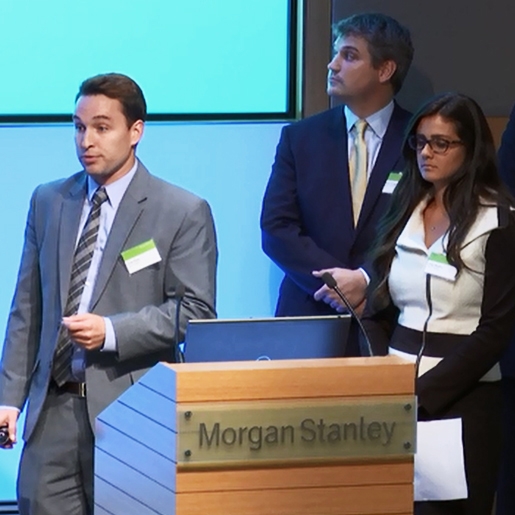Inaugural $500 million offering is part of firm's efforts to drive sustainable investing.
Overview
On June 8, 2015, Morgan Stanley issued a $500 million green bond, to help fund the development of renewable energy and energy efficiency, which help avoid and reduce greenhouse gas emissions.
Ahead of this offering, Morgan Stanley created a green bond framework that describes the process through which projects are selected to receive funding, with the aim of ensuring that the Morgan Stanley green bond operates with high levels of transparency, disclosure and verification. To provide additional transparency to our process, DNV GL, an independent certification expert in renewables and energy efficiency, reviewed Morgan Stanley’s internal green bond framework and its adherence to the Green Bond Principles, which are voluntary guidelines for the development and issuance of green bonds, encouraging transparency, disclosure and integrity in the development of the green bond market. Disbursements to eligible green projects were limited to those reviewed by DNV GL. In its second party opinion, DNV GL indicated that the projects are “providing clear environmental benefits, either through the production of renewable energy or the reduced consumption of energy.” I
Proceeds from the sale of the notes were deposited into a Morgan Stanley account for tracking disbursements. Morgan Stanley and its consolidated subsidiaries allocated funds in amounts equal to the balance of this account to renewable energy and energy efficiency projects. Pending allocation, remaining net proceeds were invested in cash, cash equivalents, U.S. government securities, U.S. agency securities, U.S. agency mortgage-backed securities or non-U.S. government securities. By December 31, 2015, all of the net proceeds of this issuance were allocated to eligible green projects.
To review the Prospectus, Prospectus Supplement, and Pricing Supplement for this issuance, please click here.
To review the Report on Use of Proceeds Attestation and Management’s Assertion, please click here.
Portfolio ImpactsII
The total installed capacity of these projects amounts to 1,054 MW with a potential annual renewable energy output of 4.1 million MWh and an estimated avoidance of 2.4 million tons CO2 equivalent per year. The energy efficiency project associated with this green bond promotes energy conservation for Morgan Stanley’s own operations and will amount to an estimated 73 percent reduction from the pre-conversion energy usage of these fixtures.
| Total installed renewable energy capacity | 1,054 MW |
| Potential annual renewable energy output | 4.1 million MWh |
| Estimated annual energy savings | 149,100 kWh |
| Estimated annual GHG avoided | 2.4 million CO2e tons |
Projects
Below are the projects associated with the inaugural Morgan Stanley green bond.III
Renewable Energy
Route 66 Wind
Status: In commercial operation
Route 66 Wind is a 150 MW wind power project developed by First Wind (now part of SunEdison), a North American renewable energy company focused on the development, financing, construction, ownership and operation of utility-scale power projects in the United States. Located in Armstrong and Carson Counties, Texas, the project is comprised of 75 Vestas V110 turbines with a capacity of 2 MW each and delivers power to the Electric Reliability Council of Texas electricity market through the Competitive Renewable Energy Zone transmission system.
Morgan Stanley, through its affiliates, provided a financing solution that includes a tax equity partnership commitment to support the project.
Stephens Ranch II
Status: In commercial operation
Stephens Ranch II is a 165 MW wind power project that represents the second of two phases that total 377 MW. Located near Lynn and Borden Counties, Texas, Stephens Ranch II utilizes GE 1.7-100 turbines. The project’s sponsor is Starwood Energy Group, which specializes in energy infrastructure investments, with a focus on natural gas and renewable power generation and transmission sectors.
Morgan Stanley, through its affiliates, provided a financing solution that includes a tax equity partnership commitment to support the project.
Rattlesnake Wind Energy Center
Status: In commercial operation
Rattlesnake Wind Energy Center is a 207 MW wind power project that consists of 118 GE 1.7 MW wind turbines. Located approximately 40 miles southeast of Midland in Glasscock County, Texas, the output feeds into the Competitive Renewable Energy Zone transmission system. The project is developed by Invenergy, a developer of large-scale clean energy and storage facilities in North America and Europe.
Morgan Stanley, through its affiliates, provided a financing solution that includes non-recourse project construction financing and term debt to support the project.
Briscoe Wind Farm
Status: In commercial operation
Briscoe Wind Farm is a 150 MW wind power project in Briscoe County, Texas. The project utilizes 81 GE 1.85-87 wind turbines and the resulting electricity is sold in the Electric Reliability Council of Texas electricity market. The project‘s sponsor is Capital Dynamics, an independent global asset manager investing in private equity and clean energy infrastructure.
Morgan Stanley, through its affiliates, provided a financing solution that includes non-recourse project construction financing and a tax equity partnership commitment to support the project.
Unnamed Wind Project #1
Status: In commercial operation
Morgan Stanley, through its affiliates, provided a financing solution that includes a tax equity partnership commitment to support the development of the project. The project is developed by an independent wind development company.
Unnamed Wind Project #2
Status: In commercial operation
Morgan Stanley, through its affiliates, provided a financing solution that includes non-recourse project construction financing and a tax equity partnership commitment to support the development the project. The project is being developed by an independent wind development company.
Energy Efficiency
Status: The project associated with this issuance is complete
An energy reduction project completed in 2014 entailed upgrading existing exterior lighting fixtures to LED technology at a Morgan Stanley office in the New York City metro area. The anticipated result of this project is a decrease in electricity consumption by 149,000 kilowatt hours annually, which equates to a 73% reduction from the pre-conversion energy usage of these fixtures.
[I] DNV GL Second Party Opinion to the Morgan Stanley Green Bond (March 2015)
[II] Quantitative estimates represent aggregate, ex ante projects developed in conjunction with WSP USA, a professional services firm. Morgan Stanley retained WSP USA to calculate representative, annualized greenhouse gas (GHG) emissions avoidance resulting from the generation of electricity from the Renewable Energy Investments and Energy Efficiency Investments. For Renewable Energy Investments, avoided greenhouse gas emissions were estimated using the approach outlined in the WRI GHG Protocol’s Project Protocol. Unnamed Wind Project #1 and #2 details are not disclosed due to confidentiality obligations. The Portfolio Impacts figures include these projects. For Energy Efficiency Investments, emission savings were estimated by calculating the electricity consumption of each fixture type using the existing lamp type and again using a high efficiency LED replacement.
[III]The information below has been excerpted from press releases issued by the developer of the relevant project where appropriate.



